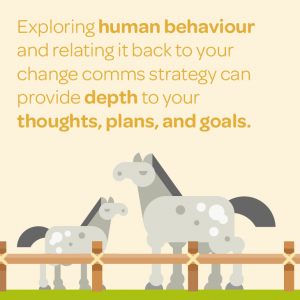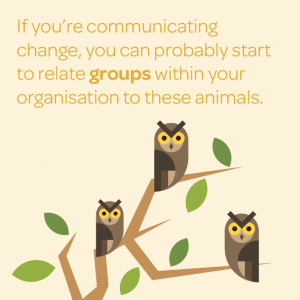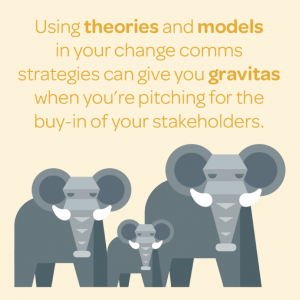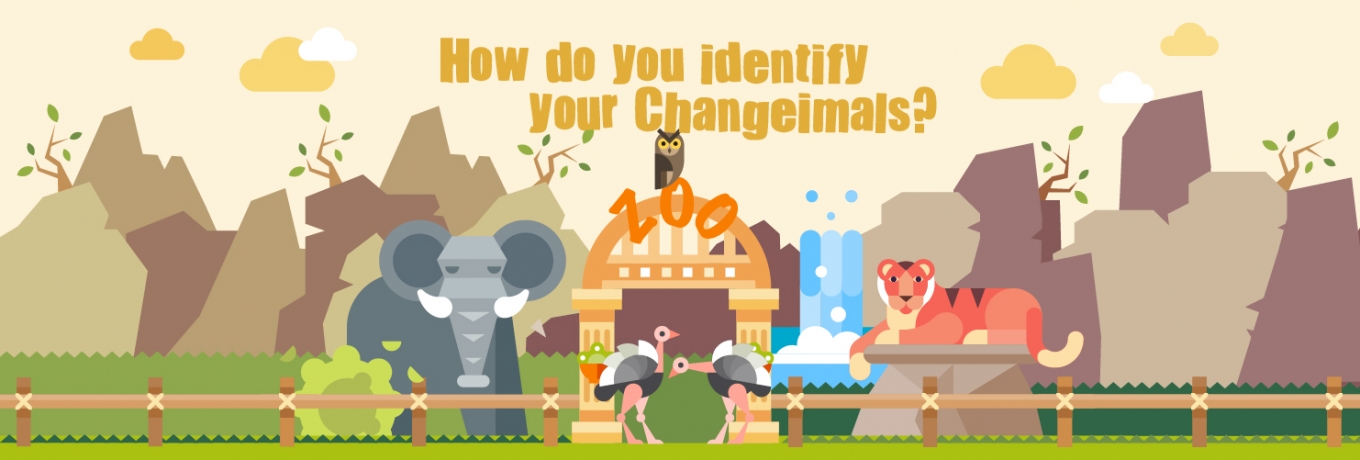Hatchimals were last year’s must-have toy. By changing the Hatchimal’s environment – its egg – an animal hatches from within. In times of change, employees can metaphorically become animals… or Changeimals, as we like to call them.
Here we explore some of those animals, how they react to change and how understanding those reactions can help to shape our strategies.
People are hugely complex. By exploring human behaviour and psychology, and relating it back to your change communications strategy, it can provide depth to your thoughts, plans, and goals.
David Straker, the founder of changingminds.org, came up with the concept of animals metaphorically representing how people react to change.
He called it The Resistance Zoo. 
It features six animals that all hatch during times of change…
- Ostriches. No introduction needed to this one. One sniff of danger and their heads shoot straight down in the sand. They believe that if they can’t see the change, it can’t hurt them.
- Moles. The sneaky little moles hide underground, and just when you think your change project is complete, up they pop to make a mess of things.
- Tigers. They’re the ones to fear. And they like to make sure you do too. Their claws are out, and they’ll fight your change programme to the very end.
- Dogs. They’re individually powerful and brave, but know that together they’re stronger. They’ll seek out the other dogs and create a pack. They’ll fight dirty, and will rip your change programme apart, given half the chance.
- Owls. Wise and knowledgeable, they perch up high, looking down on everyone. They believe they know better and like to point out all the little faults in your change project.
- Snails. Slowly creeping along at their own pace, they hope that they’ll go undetected and the change will pass them by unscathed.
 David said that he experienced all of these animals in his change career. If you’re communicating change – and who isn’t? – you can probably start to relate groups within your organisation to these animals.
David said that he experienced all of these animals in his change career. If you’re communicating change – and who isn’t? – you can probably start to relate groups within your organisation to these animals.
A bit of fun and a lot of serious
As we’ve travelled on our own change safaris, we’ve come across some animals of our own. Welcome to the Alive additions to The Resistance Zoo…
- Elephants. They’re intensely emotional. They feel deep sadness, grief, and can even suffer post-traumatic stress. They need a lot of TLC, and as communicators we need to be wary of their sensitivities.
- Donkeys. You know the saying… stubborn as a mule. Those donkeys won’t be going along easily with your change programme. You’ll have to pull some impressive moves to get your communications to cut through all that stubbornness and cynicism.
- Horses. It’s often said that the horse helped man conquer the world. In every change programme you need your loyal horses by your side. They’re unfalteringly hard working and will work tirelessly to help you achieve your change goals.
From the zoo to the workplace
It’s great to use theories and models when you’re hatching your change communications strategy, and having a theological base can give you gravitas when you’re pitching for the buy-in of your stakeholders.
- Use it in audience segmentation.Identifying and segmenting your audience is a key first step in any internal communications plan. When you’re segmenting for a change strategy, why not turn some heads by using animal metaphors?

- Use it to map your stakeholders.A sometimes overlooked area of an internal communications strategy, but something that can be really useful for change communications to help you identify and target change agents, enablers and blockers. You might find that the animals slot nicely into a stakeholder map, or could even deserve one of their own.
- Use it to plot people along the change curve. The Kubler-Ross change curve model is a stalwart of change communications. It maps people on their journey as they move from denial and anger, onto acceptance. Rather than simply plotting your audience along the curve, you could use animals instead.
- Use it to break the ice. If you’re presenting your change communications strategy to stakeholders, speaking at a conference, or sharing your work with your team, the metaphorical use of animals can be a great ice breaker to get them to think about the people being affected by change. They’ll remember it too.
Add to the collection
All experiences of change are different. People react in unique ways, and organisations handle change in their own style.
We’d love to build on our collection of Changeimals.
Who would you add to the zoo?
















